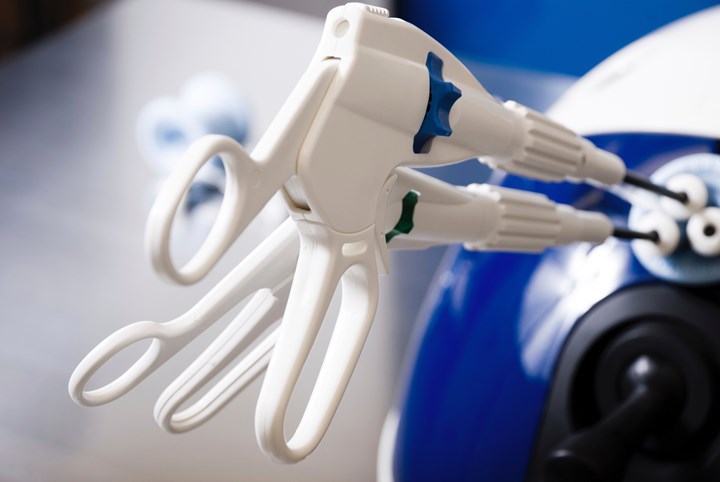
Use dry lubricant that is certified as ISO 10993 tested to ensure the lubricant is suitable for medical device use. Photo Credit: All photos courtesy of MicroCare
In the medical device industry, manufacturing engineers often design small, complex medical tools and devices featuring moving parts that rock, twist, pivot or slide. Surgical staplers, forceps, retractors, clamps, scissors, cutters and snares are all examples of tools that must smoothly actuate without sticking or friction. But as these tools become more complex, engineers must account for how stacked tolerances impact both the assembly and ultimately the function of a device.

Overly-tight components caused by stacked tolerances may restrict their operation and require excessive force to actuate.
For example, when a medical stapler is assembled, the tolerances of each metal stamping, spring or other moving component in the device may begin to combine in such a way that the assembly of the stapler is more difficult and slower. Stacked tolerances can also present a problem all the way down to the end user. Overly-tight components caused by stacked tolerances may degrade or restrict the movement of the device and require excessive force to actuate, or operate the device.
Featured Content

Dipping provides a consistent and uniform lubricant coating to any surface geometry including internal surfaces.
Some device manufacturers opt to use functional coatings to reduce the impact of stacked tolerances, and the associated stiction, by using silicone oils or greases during assembly. But those lubricants can be expensive, messy and difficult to apply, making process and cleanroom validations complex. Lubricating with a dry coating, such as PTFE (polytetrafluoroethylene) suspended in a high-purity, nonflammable carrier fluid presents an easier, less-expensive and cleanroom-friendly option. PTFE is a non-stick lubricant made from a non-migrating synthetic polymer consisting of carbon and fluorine. In addition to providing lubricity, it also helps parts tolerate exposure to water, oils, chemicals, abrasion and high temperatures. PTFE coatings are commonly used on single-use medical devices that function outside of the body. PTFE is an easy-to-apply means to reduce the coefficient of friction and minimize the amount of force required to actuate most devices by up to 30 percent.
However, not all dry lubricants are the same, and one lubricant is not right for every application. Here are some key factors to consider when choosing a lubricant coating for a medical device.
Low viscosity carrier
The carrier fluid for the PTFE ideally disperses the coating onto the treated surface then quickly evaporates, leaving a very thin, dry, uniform layer of dry lubricant on the surface of the treated part. The carrier fluid should be low viscosity to wet all surfaces and conform to the treated parts’ surface geometry, including internal surfaces. This ensures a highly consistent surface coating in high-volume production environments, even on complex geometries or assemblies.
Hostile to biologic contamination
Look for a dry lubricant that is certified as ISO 10993 tested to ensure the lubricant is suitable for medical device use. The carrier fluid should be solvent-based so that it can resist bacterial growth and other bioburden issues associated with water. A well-chosen carrier fluid will be pyrogenically-inert and fast drying so it does not remain on the finished part, leaving only the lubricant film exposed to post assembly EtO (Ethylene Oxide), ultrasonic or radiation sterilization processes.
Non-Migrating
The coating should not migrate or transfer from the treated part to the packaging or other untreated surfaces. This transfer can compromise the later application of surface treatments such as markings or medication, or cause staining on packaging or other cosmetic issues which are unacceptable in the medical industry. It should stay where it is applied, reducing the expense of added housekeeping common when oils are used. This feature is an essential attribute especially when the coating is applied in, and validated for, use in a manufacturing cleanroom environment.
Materials compatible
The dry lubricant should be safe to use and effective on a variety of materials including metal, glass, plastic and ceramic parts commonly used on medical devices. It should dry to a uniform, durable finish without any staining or unsightly clumps, drips or runs that might otherwise obscure required unique device identification (UDI) markings.
Nonflammable
Choose a dry lubricant carrier fluid that is nonflammable. This reduces shipping and storage costs while maintaining a safe work area when it is applied to devices. This is especially important for high-volume, high-speed production facilities. Many mechanical assembly operations are prone to static discharge, so non-flammability for safety during use is essential.
Simple to apply
The dry lubricant should be easy to apply and incorporate into in-house assembly processes. It should come with factory-precise calibration from the provider and packaged ready-to-use, minimizing labor-wasting mixing or batching inconsistencies. There should be no need to outsource the coating process, adding to their cost-effectiveness.
Dry lubricant is typically applied using one of three methods. A knowledgeable coatings partner can recommend the best process for your particular application.
Dipping is most commonly used for high volume production and is suitable for coating complex assemblies or small parts, metal stampings, coils of wire and irregular shapes. Dipping provides a consistent and uniform coating to virtually any surface geometry as well as internal surfaces. The coating level is determined by the percent concentration of solids, rate of withdrawal, and number of applications. A single dip is typically adequate for most uses.
Wiping or Brushing is used most often for moderate to low production runs. It is useful for coating continuous surfaces such as rods, tubing or sheets. In addition, wiping and brushing are appropriate for coating small, selected areas of a larger part. One variation of this method is flood coating, followed by wiping.
Spraying can be done manually using a hand-held spray gun or with automatic high volume low pressure (HVLP) spray heads. Some aerosol sprays have very tight spray patterns enabling pin-point lubrication, which is helpful for hinges and pivot points. Typically, a succession of thin coats, allowing the surface to dry between applications, is better than the application of a single thick coating which can take longer to dry and can cause uneven coverage and poor adhesion.
Post-application considerations
Air Drying is best done in areas that are free of dust. Drying times of coatings are dependent on the carrier fluid and the thickness of the lubricant application. Increasing the temperature of the treated part may reduce drying times, especially on the internal surfaces of complex assemblies.
Heat Curing, or Melt-Coating is used in some applications when a more durable or permanent coating is needed. A brief heat-treating process turns the coating into a harder finish for longer service life. Heating turns many dry lubricants completely clear, so it appears nothing is on the surface of the device. This is particularly helpful if the coating needs to be semi-permanent, or if it needs to be invisible on the device.
An added production benefit
In some instances, lubricating coatings are also used on the manufacturing equipment and assembly fixtures themselves to help speed the production of plastic and metal components. They are used on chains and pulleys, metal extrusions, machine window guides and door tracks, chutes and slides, conveyors and almost any other surface or assembly that requires a clean, durable, slick coating for optimum performance. Lubricating coatings are also used to release plastic parts from their injection mold die cavities without leaving an oily film.

Surgical tools must smoothly actuate without stiction.
The bottom line
Dry lubricants provide a cost-effective and efficient solution to address the manufacturing challenges of stacked tolerances, tight-fitting parts and friction on complex mechanical assemblies. When specifying a lubricant coating, the device and parts manufacturer should look for a supplier that provides expert advice to help them simplify the selection process. This includes individualized consulting, in-lab testing, and the ability to provide both off-the-shelf and customized formulations to ensure the right dry lubricant coating for their finished product.
About the Author

Jay Tourigny
Jay Tourigny is Senior Vice President at MicroCare Medical which offers medical device cleaning and lubricating solutions. He has been in the industry for more than 30 years and holds numerous U.S. patents for cleaning-related products that are used on a daily basis in medical and precision cleaning applications. For more information, visit www.microcare.com.
RELATED CONTENT
-
ISO 14000: Environmental Management
What is it? What is required? Other companys' experiences...
-
Matt Kirchner: Porter’s Five Forces in the Finishing Industry
Higher barriers to entry, minimal competitive rivalry, fewer substitutes and less powerful customers and suppliers—pay heed to Porter’s Five Forces and your next expansion will more likely be a lucrative one.
-
Dear Valued Supplier
"Dear valued supplier," the letter begins.



















